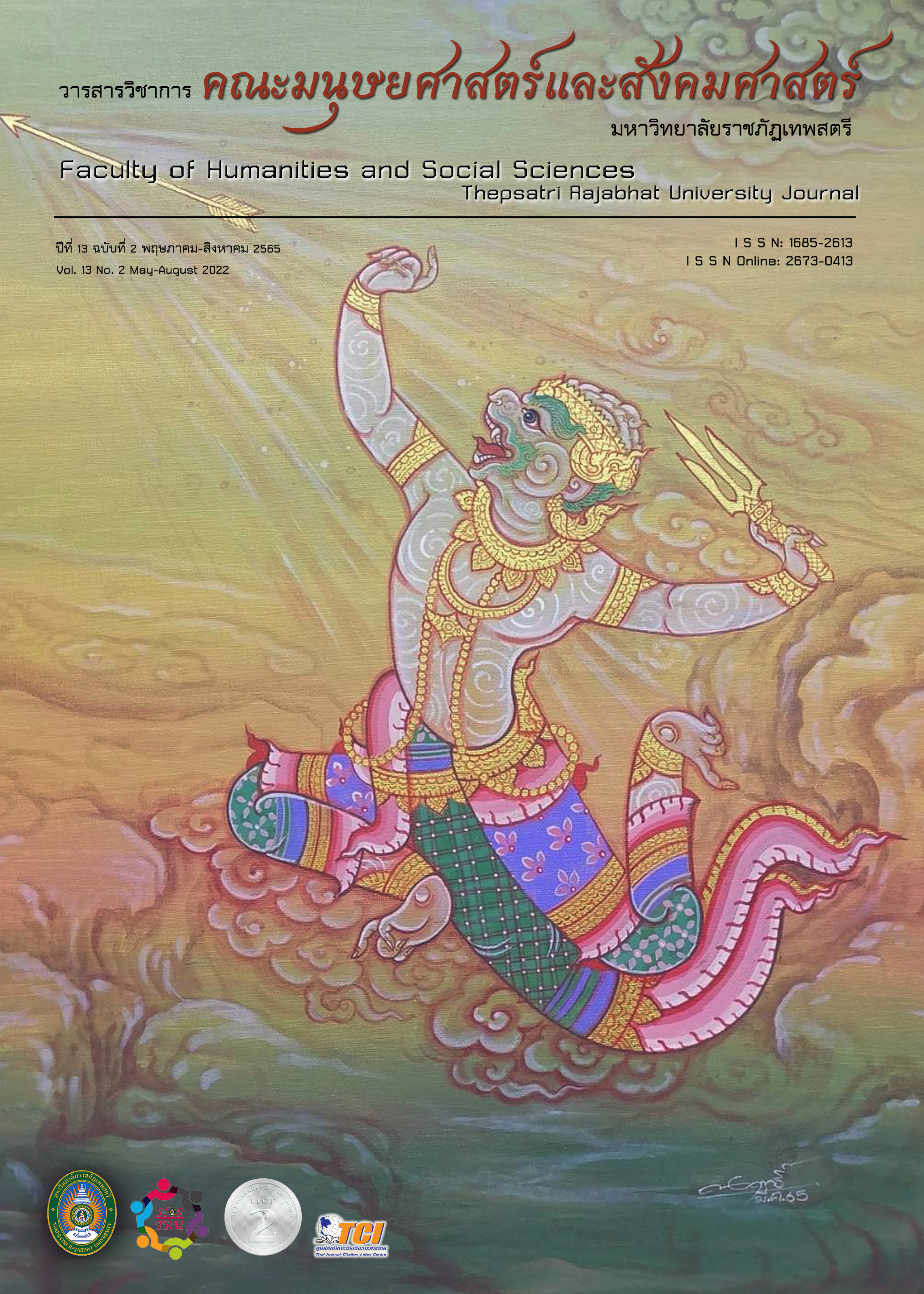ปัจจัยการยอมรับเทคโนโลยีดิจิทัลที่ส่งผลต่อการตัดสินใจใช้บริการเทเลเฮลธ์หลังวิกฤติการณ์โควิด-19
Main Article Content
บทคัดย่อ
การวิจัยนี้มีวัตถุประสงค์เพื่อศึกษาถึงปัจจัยการยอมรับเทคโนโลยีดิจิทัลที่ส่งผลต่อการตัดสินใจใช้บริการเทเลเฮลธ์ และอิทธิพลของปัจจัยการยอมรับเทคโนโลยีดิจิทัลที่มีผลต่อการตัดสินใจใช้บริการเทเลเฮลธ์ กลุ่มตัวอย่าง ที่ใช้ในการวิจัย คือ ประชาชนในประเทศไทยที่มีอายุตั้งแต่ 18 ปีขึ้นไป จำนวน 400 ตัวอย่าง เครื่องมือที่ใช้ในการวิจัย คือ แบบสอบถามออนไลน์ ซึ่งแบ่งออกเป็น 4 ส่วน ได้แก่ 1) ลักษณะทางประชากรศาสตร์ 2) พฤติกรรมการใช้บริการเทเลเฮลธ์ 3) การยอมรับเทคโนโลยีดิจิทัลที่ส่งผลต่อการตัดสินใจใช้บริการเทเลเฮลธ์ และ 4) การตัดสินใจใช้บริการ โดยได้รับการตอบกลับของแบบสอบถามจำนวน 428 ตัวอย่าง จากนั้นได้นำมาตรวจสอบความถูกต้องของข้อมูล คงเหลือ 400 ตัวอย่าง และนำมาวิเคราะห์ข้อมูลเพื่อหาค่าเฉลี่ยเลขคณิต ค่าส่วนเบี่ยงเบนมาตรฐาน การวิเคราะห์ค่าสัมประสิทธิ์สหสัมพันธ์แบบเพียร์สัน และการวิเคราะห์สมการถดถอยพหุคูณแบบขั้นตอน
ผลการวิจัยพบว่า ปัจจัยด้านการยอมรับเทคโนโลยีดิจิทัลทั้ง 4 ด้าน ได้แก่ 1. ประโยชน์จากการใช้งาน 2. ความยากง่ายในการใช้งาน 3. ความปลอดภัยในการใช้งาน และ 4. ความเชื่อมั่นต่อผู้ให้บริการ มีค่าเฉลี่ยอยู่ในระดับมาก และผลการวิเคราะห์อิทธิพลของปัจจัยการยอมรับเทคโนโลยีดิจิทัลต่อการตัดสินใจใช้บริการเทเลเฮลธ์พบว่า ประโยชน์จากการใช้งาน ความปลอดภัยในการใช้งาน และความเชื่อมั่นต่อผู้ให้บริการมีอิทธิพลต่อการตัดสินใจใช้บริการโทรเวชกรรมอย่างมีนัยสำคัญทางสถิติที่ระดับ 0.05 และมีค่า R-square = 0.224 โดยที่ค่าคะแนนเฉลี่ย ด้านประโยชน์จากการใช้งานที่เพิ่มขึ้น 1 คะแนน ส่งผลให้คะแนนเฉลี่ยการตัดสินใจใช้บริการเทเลเฮลธ์เพิ่มขึ้น 0.237 คะแนน ค่าคะแนนเฉลี่ยด้านความปลอดภัยในการใช้งานส่งผลให้คะแนนเฉลี่ยต่อการตัดสินใจใช้บริการเทเลเฮลธ์เพิ่มขึ้น 0.167 คะแนน และค่าคะแนนเฉลี่ยด้านความเชื่อมั่นต่อผู้ให้บริการส่งผลให้คะแนนเฉลี่ยต่อการตัดสินใจใช้บริการเทเลเฮลธ์เพิ่มขึ้น 0.164 คะแนน
Downloads
Article Details

อนุญาตภายใต้เงื่อนไข Creative Commons Attribution-NonCommercial-NoDerivatives 4.0 International License.
เนื้อหาและข้อมูลในบทความที่ตีพิมพ์ในวารสารวิชาการคณะมนุษยศาสตร์และสังคมศาสตร์ มหาวิทยาลัยราชภัฏเทพสตรี ถือเป็นข้อคิดเห็นและความรับผิดชอบของผู้เขียนบทความโดยตรง ซึ่งกองบรรณาธิการวารสารไม่จำเป็นต้องเห็นด้วย หรือร่วมรับผิดชอบใดๆ
บทความ ข้อมูล เนื้อหา รูปภาพ ที่ได้รับการตีพิมพ์ในวารสารวิชาการคณะมนุษยศาสตร์และสังคมศาสตร์ มหาวิทยาลัยราชภัฏเทพสตรี ถือเป็นลิขสิทธิ์ของวารสารวิชาการคณะมนุษยศาสตร์และสังคมศาสตร์ มหาวิทยาลัยราชภัฏเทพสตรี หากบุคคลหรือหน่วยงานใดต้องการนำทั้งหมดหรือส่วนหนึ่งส่วนใดไปเผยแพร่ต่าหรือกระทำการใดๆ จะต้องได้รับอนาญาตจากวารสารวิชาการ ฯ ก่อนเท่านั้น
เอกสารอ้างอิง
กรมควบคุมโรค. (2564). สถานการณ์ผู้ติดเชื้อ COVID-19 อัพเดทรายวัน. สืบค้น กันยายน 25, 2564 จาก https://ddc.moph.go.th/covid19-dashboard/.
ฉัตยาพร เสมอใจ. (2550). พฤติกรรมผู้บริโภค. กรุงเทพฯ: บริษัท ซีเอ็ดยูเคชั่น จำกัด.
ธีรภัทร อดุลยธรรม. (2563). Cloud Meeting-Telemedicine กับ บุคลากรทางการแพทย์ในยุคโควิด-19. Journal of The Department of Medical Services, 45(2), 5 - 7.
ยุทธ ไกยวรรณ์. (2550). การวิจัยเพื่อการบริหารงานอุตสาหกรรม. กรุงเทพ: ศูนย์ส่งเสริมสื่อกรุงเทพ.
สิงหะ ฉวีสุข, และสุนันทา วงศ์จตุรภัทร. (2555). ทฤษฎีการยอมรับการใช้เทคโนโลยีสารสนเทศ. วารสารเทคโนโลยีสารสนเทศลาดกระบัง, 1(1), 1-21.
สำนักงานสถิติแห่งชาติ. (2563). จำนวนประชากรจากการทะเบียน จำแนกตามอายุ เพศ และจังหวัด พ.ศ. 2563. สืบค้น กันยายน 15, 2564 จาก http://statbbi.nso.go.th/staticreport/page/sector/th/01.aspx.
ศิริรัตน์ วงศ์ประกรณ์กุล. (2563). ยุคใหม่ของการดูแลสุขภาพด้วยระบบนิเวศทางธุรกิจและเทเลเฮลธ์. วารสาร Mahidol R2R e-Journal, 7(2), 1 - 15.
Bhattacherjee, A., & Hikmet, N. (2007). Physicians’ Resistance Toward Healthcare in- Formation Technology: A Theoretical Model and Empirical Test. European Journal of Information Systems, 16(6), 725 – 737.
Boot, W.R., Best, R., Charness, N., Kort, H.S.M., van Houwelingen, C.T.M., & Barakat, A. (2015, November). Exploring Factors Influencing US Nurses' Willingness to Use Telehealth Technology. The Gerontologist, 55(suppl.2), 767.
Bull, T.P., Dewar, A.R., Malvey, D.M., & Szalma, J.L. (2016, July - December). Considerations For The Telehealth Systems of Tomorrow: An Analysis of Student Perceptions of Telehealth Technologies. JMIR Medical Education, 2(2), e11, 1 - 12.
Chatzoglou, P.D., Sarigiannidis, L., Vraimaki, E., & Diamantidis, A. (2009, November). Investigating Greek Employees’ Intention to Use Web-based Training. Computers & Education, 53(3), 877 – 889.
Cimperman, M., Brenčič, M. M., & Trkman, P. (2016, June). Analyzing Older Users’ Home Telehealth Services Acceptance Behavior – Applying an Extended UTAUT Model. International Journal of Medical Informatics, 90, 22 - 31.
Demiris, G., Speedie, S.M., & Finkelstein, S. (2001, September). Change of Patients' Perceptions of Tele Home Care. Telemedicine Journal and e-Health, 7(3), 241 – 248.
Hall, A.K., Dodd, V., Harris, A., McArthur, K., & Dacso, C. (2014, April). Colton LM. Heart Failure Patients’ Perceptions and Use of Technology to Manage Disease Symptoms. Telemedicine and e-Health, 20(4), 324 – 331.
Haque, S. N., Banger, A., DeStephano, S., Rutledge, R., & Romaire, M. (2019). Factors Influencing Telehealth Adoption in Critical Access Hospitals: Insights from a Demonstration. In AMIA, RTI International, Research Triangle Park, NC.
Mckinsey. (2020). Telehealth Has Surged Under COVID-19. Retrieved September 25, 2021, from https://www.mckinsey.com/industries/healthcare-systems-and-services/our-insights/telehealth-a-quarter-trillion-dollar-post-covid-19-reality.
Rahimpour, M., Lovell, N.H., Celler, B.G., & McCormick, J. (2008, July). Patients' Perceptions of a Home Telecare System. International Journal of Medical Informatics, 77(7), 486–498.
Sarlan, A., Ahmad, R., Ahmad, W. F. W., & Dominic, P. D. D. (2012, June). Users' Behavioral Intention to Use Clinic Information System: A Survey. In 2012 International Conference on Computer & Information Science (ICCIS) (Vol. 1, pp. 37-43). IEEE.
Seto, E., Leonard, K.J., Masino, C., Cafazzo, J.A., Barnsley, J., & Ross, H.J. (2010, October - December). Attitudes of Heart Failure Patients and Health care Providers towards Mobile Phone-Based Remote Monitoring. Journal of Medical Internet Research, 12(4), 56 – 65.
Taylor, J., Coates, E., Brewster, L., Mountain, G., Wessels, B., & Hawley, M. S. (2015). Examining The Use of Telehealth in Community Nursing: Identifying The Factors Affecting Frontline Staff Acceptance and Telehealth Adoption. Journal of advanced nursing, 71(2), 326 - 337.
Tsai, C. H. (2014). Integrating Social Capital Theory, Social Cognitive Theory, and The Technology Acceptance Model to Explore a Behavioral Model of Telehealth Systems. International Journal of Environmental Research and Public Health, 11(5), 4905 - 4925.
Tsai, J.-M., Cheng, M.-J., Tsai, H.-H., Hung, S.-W., & Chen, Y.-L. (2019, December). Acceptance and Resistance of Telehealth: The Perspective of Dual-Factor Concepts in Technology Adoption. International Journal of Information Management, 49, 34 - 44.
Venkatesh, V., Morris, M.G., Davis, G.B., & Davis, F.D. (2003, September). User Acceptance of Information Technology: Toward a Unified View. MIS Quarterly, 27(3), 425 - 478.
Woo, K., & Dowding, D.W. (2020, April). Decision-Making Factors Associated With Telehealth Adoption By Patients With Heart Failure at Home: A Qualitative Study. CIN: Computers, Informatics, Nursing, 38(4), 204 - 214.
Yamane, T. (1967). Statistics: An Introductory Analysis. New York: Harper and Row.


